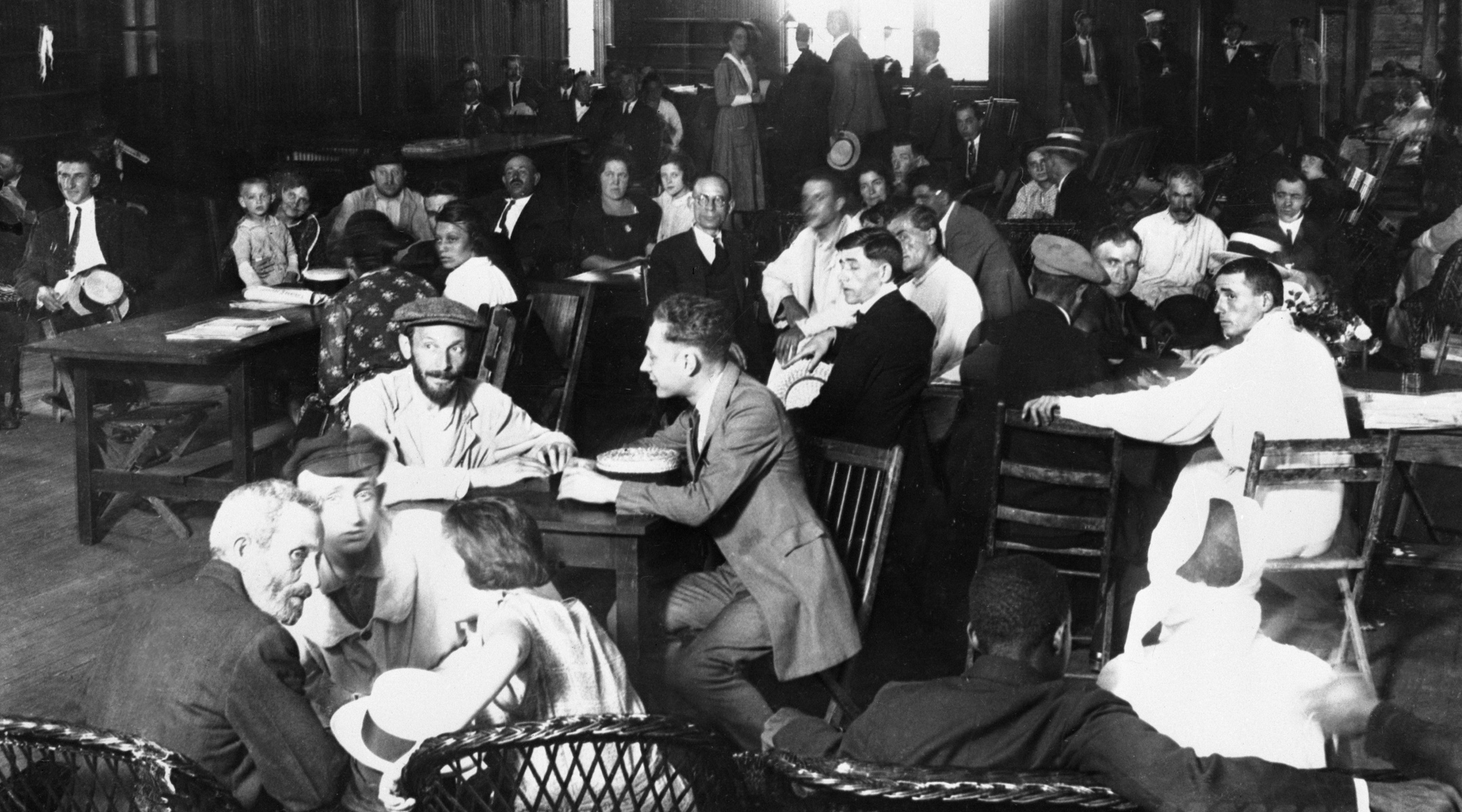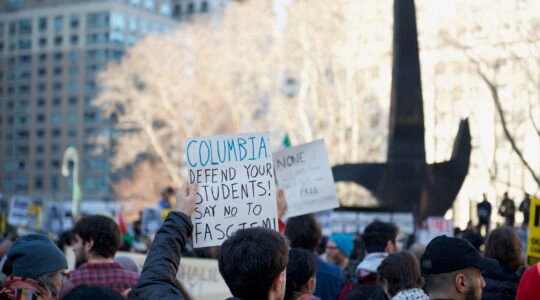(JTA) — In May 1924, President Calvin Coolidge signed legislation, known as the Johnson-Reed Act, that severely restricted the number of immigrants by putting quotas on their country of origin, and completely excluded immigrants from Asia.
Among other things, the act brought to an end a historic migration of Jews to the United States, and set in place restrictions that would keep Jewish refugees out when the Nazis rose to power a decade later.
Jews weren’t the only targets of nativists who pressed for immigration quotas — the law drastically cut the number of Italians, Greeks and Eastern Europeans who could enter the country. Nor was the act unprecedented — in 1882, Congress passed the Chinese Exclusion Act banning Chinese laborers, and in 1921 imposed an Emergency Quota Act putting a cap on European immigration.
But Johnson-Reed cemented a change in how America viewed immigration, from a policy of largely open borders to a new emphasis on “desirables” and “undesirables.” Its Senate sponsor, David Reed of Pennsylvania, wrote in the New York Times that the law’s goal was to make the United States a more “homogenous” country.
It set the terms for a debate that if anything has become more intense exactly 100 years later.
Daniel Okrent, author of the 2020 book “The Guarded Gate,” a history of the Johnson-Reed era, has characterized anti-immigrant sentiments of the last century that sound familiar today. “‘We can’t let this happen to us. We can’t let this happen to our cities. We can’t let this happen to our school systems,’” is how he described them to an interviewer. “There was an openly prejudicial view that they wanted to save themselves by keeping out ‘the other.’”
The anniversary of Johnson-Reed is an occasion to remember America’s fraught relationship with immigration, and how Jewish history was shaped by migration and restrictions. On April 7, the Center of Jewish History in Manhattan hosted a symposium, “Reconsidering Jewish Migration to the United States: A Century of Controversy.”
I spoke to a few of the scholars and activists who will be speaking at the symposium, asking about the historical context of Johnson-Reed and its legacy. I edited our conversations into a virtual roundtable on immigration and its discontents, then and now.
The participants:
Hasia Diner, professor emerita at New York University and co-editor of “Immigration: An American History.”
Mark Hetfield, president and CEO of HIAS, the Jewish community’s international refugee agency.
Deborah Dash Moore, Frederick G. L. Huetwell Professor of History and Professor of Judaic Studies at the University of Michigan.
Beth S. Wenger, the Moritz and Josephine Berg Professor of History and Associate Dean for Graduate Studies in the School of Arts & Sciences at the University of Pennsylvania.
Our conversations were edited for length and clarity.

From left: Mark Hetfield, Hasia Diner, Deborah Dash Moore and Beth Wenger. (Andrew Rozario/HIAS; Courtesy)
The anti-immigrant fervor after World War I climaxes with the passage of the Immigration Act of 1924, known as Johnson-Reed after its Congressional sponsors. What were the factors that brought it about?
Deborah Dash Moore: Johnson-Reed happens at the time of the rise of the Ku Klux Klan and notions of white supremacy, and the new Klan is anti-Catholic as well as anti-Jewish. Many of the tensions in our society, especially notions of white supremacy and Christian nationalism, find their roots and support in this era of restrictive immigration.
In Europe, people used to not just come, they also used to go back; there was movement back and forth. That’s why we talk about transnational identities, and they could have multiple allegiances as a result — which led many to vilify immigrants, which I think was part of what produced Johnson-Reed.
Hasia Diner: There are multiple forces at work. First, I think “Americans” — the white, Protestant, Anglo-Saxon — were really disturbed by World War I. Ethnic groups were lining up with their home countries, so everybody wants their voice to be heard, based on what they thought was good for their ancestral home. And just as the Austro-Hungarian empire was breaking up, many “Americans” really feared that the United States was becoming balkanized in the same way. I think of the 1924 act as an effort to end that process of balkanization.
In terms of the economy, right after World War I, there was brief panic, and a lot of labor agitation. Unions were seen in the white imagination as wrong, violent and illegal. This upsurge in union activity in the aftermath of the war was maybe icing on the cake. But in the lead up to restriction, it was way less significant than racism, international politics and a kind of understanding which grows out of both of them that there is such a thing as too much diversity. Theodore Roosevelt ran around in the early 20th century, telling white American women that it was their job to have more babies to offset the immigrants. He in fact called it “race suicide.”
Let’s talk about that racism. Journalist Daniel Okrent has written about how elites would bring eugenics — the idea of genetically superior and inferior races — “into wide public consciousness, introduce it into the nation’s political debate, and elevate it into the realm of scientific respectability.”
HD: The year 1894 is for immigration historians almost as important as 1924. That’s when the Immigration Restriction League was founded by three Harvard University alumni pressing for the exclusion of the lesser races. The rise of “scientific racism” really came to dominate intellectual and political discourse. It said that peoples of the world can be arrayed along a spectrum from civilization, with white Europeans at the top, and, at the bottom, Asians and Blacks. There are books and dictionaries and learned articles saying, “Well, should the Italians be ranked higher or lower than the Greeks? Where do the Jews fit in this?”
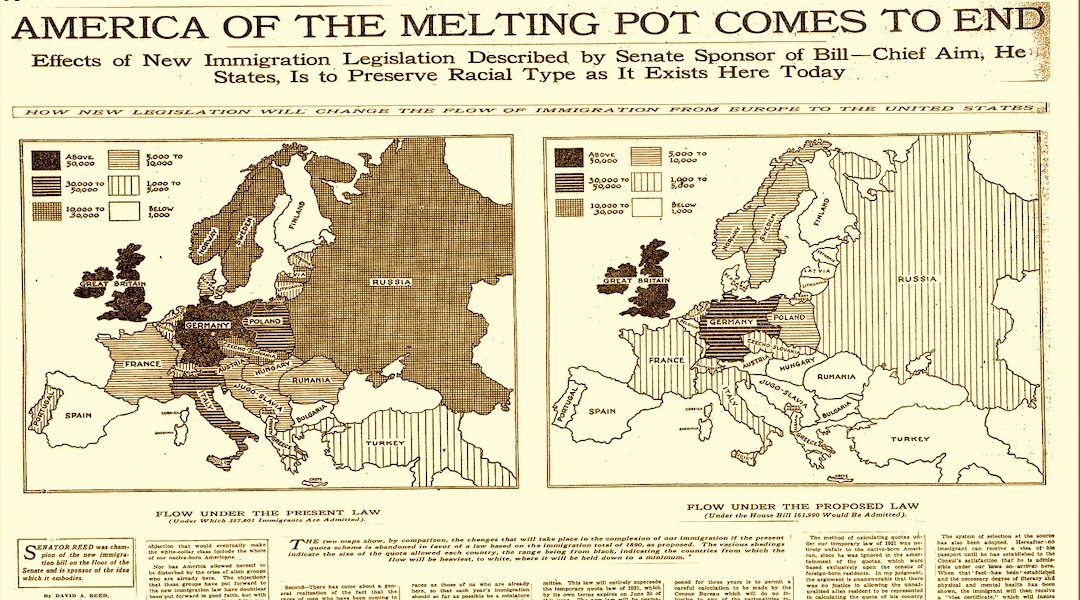
Sen. David Reed of Pennsylvania explains the legislation restricting U.S. immigration in a New York Times essay, April 27, 1924. (New York Times Archive)
Where do the Jews fit in this? There was plenty of antisemitism expressed by supporters of limits on immigration.
Beth Wenger: There was such massive Jewish immigration in this period and Jews were one of the key groups who were among the “undesirables.” In the United States there’s a vacillation in some Jewish organizations between wanting to defend open immigration against quotas, and also a fear of being associated with the “undesirable.”
HD: It was 1922 when Harvard instituted its quota on Jews, and there was talk about Jews as revolutionaries, but also as unscrupulous businessmen. There was some talk about them being dirty and tubercular and loud, noisy, always talking with their hands.
But I’m going to say something that probably many of my fellow American Jewish historians would not agree with, that it wasn’t the Jews but the Italians who were the real focus of xenophobic hysteria. And earlier it was the Irish. It’s a really interesting comparison between the United States and Great Britain, where the discussion around the 1905 Aliens Act denying entry to “undesirable immigrants” was all about Jews.
Between 1880 and 1920, more than 20 million immigrants arrive, including 3 million Jews. What does Johnson-Reed change, beside turning off the spigot of immigration?
DDM: It changes how the United States understands immigration. Prior to Johnson-Reed, although you had the Chinese Exclusion Act, and you had various tests for whether somebody is mentally ill or physically sick, or impoverished, you always had the assumption that immigration was open. And now the assumption is the reverse, that immigration is something to be controlled, something to be restricted. And that’s a real fundamental switch in thinking about the United States.
And, of course, immigration drops by 80%, which has a really big impact on immigrant groups in the U.S., because suddenly, there are no newcomers, or hardly any newcomers. And that means that these immigrant groups are going to be made up of the second generation and then third generation.
Mark Hetfield: In the 1920s, ’30s and, ’40s, as a result of the Johnson-Reed Act, HIAS became an international agency. Prior to 1921, we could stay on Ellis Island and make sure they got into the system. That was our job. Immigrants had to prove that they wouldn’t be a public charge, that they weren’t radical, but they didn’t have to do any advance work. It was all done at Ellis. And then we made sure they got kosher food on Ellis Island while they were waiting and got the legal help that they needed. And then once they got off, we either gave them shelter, mostly in what is now the Public Theater on Lafayette Street or we would get them train tickets to some other places in the United States where they would sometimes join relatives. That was the way we functioned for our first 20 years.
When Congress slammed the door shut in 1921 and 1924, we had to become an international organization because Jews couldn’t come here anymore for the most part. So we had to find other places for them to go. We had to operate in Europe and Asia and South America, to try to find some places that would accept them.
BW: Let me give you another specific example: It creates the Border Patrol, and the whole idea that the U.S. as a nation gate-keeps who comes in. This legislation firmly implanted that notion and changed some sweeping ideas about national identity about citizenship, who’s a good American. The rhetoric you see around immigration today, while obviously influenced by contemporary political and other developments, is very much a consequence of the long history of the way the U.S. came to think about immigration in the 20th century.
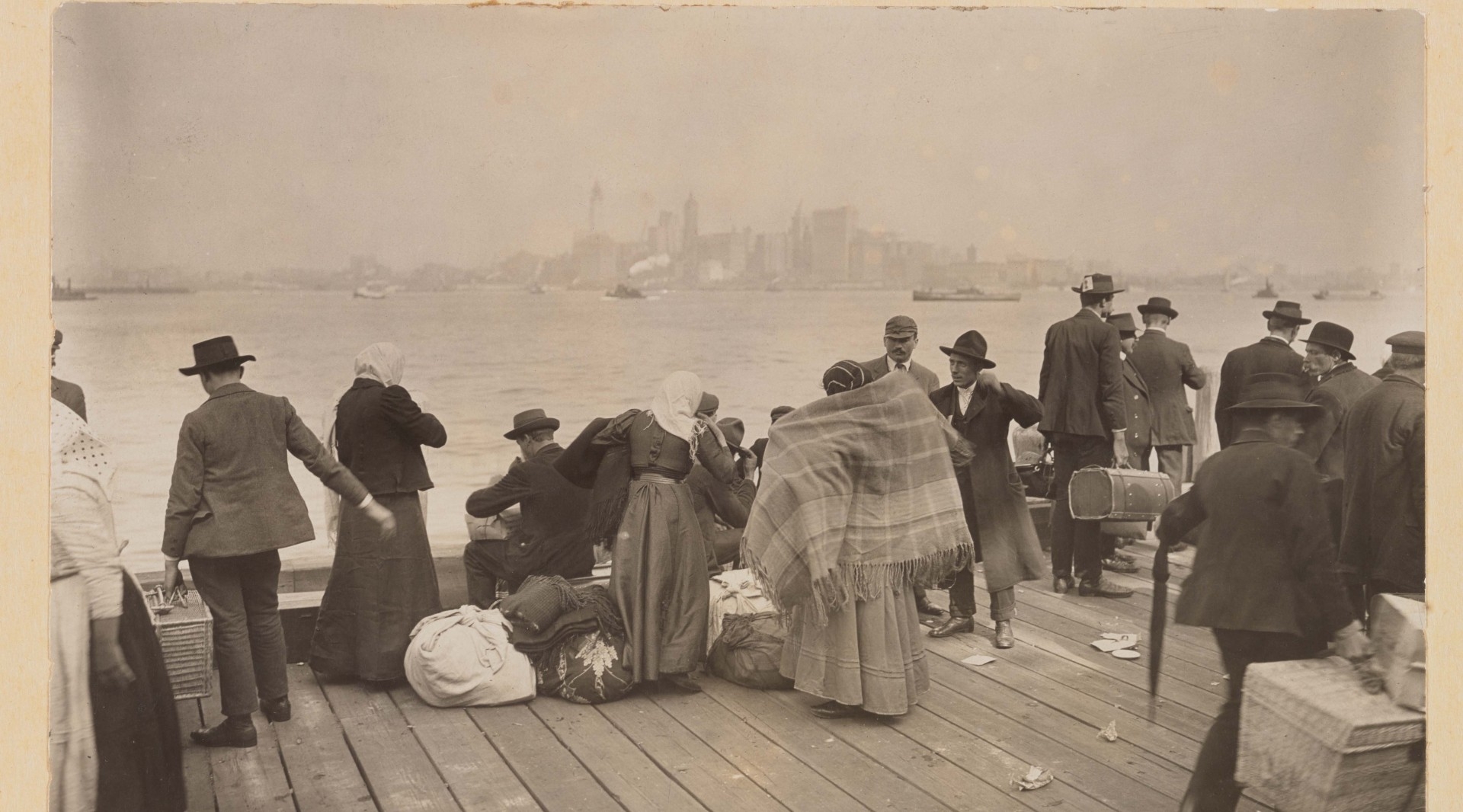
Immigrants waiting to be transferred to the U.S. mainland from Ellis Island, October 30, 1912. Congress significantly tightened its immigration policies in 1924, making immigration more difficult for Jews fleeing Nazi Germany in the 1930s. (Library of Congress)
Another major consequence is that as the Nazis came to power in the ’30s, most Jews in Europe had a very slim chance of being able to immigrate to the United States. And we know the tragic consequences.
MH: HIAS had to operate in places like Shanghai, Tokyo, South America. We couldn’t get them here. We couldn’t get them to Canada. We couldn’t get them to South Africa. We couldn’t get into Australia anymore.
HD: Antisemitism certainly ratchets up in the 1920s and the 1930s, when you have Henry Ford and America First. But again, every opinion poll done after 1935 shows that the American public does not want immigration, period.
What changes brought about by Johnson-Reed are still with us, or can we perhaps say that so many things have changed that the periods surrounding 1924 and 2024 can’t be compared?
BW: An issue that’s really so painfully with us as a nation is this idea of who is a deserving and worthy American and the things that determine that. Anti-immigrant proponents used pseudoscience to determine who is unassimilable not only culturally but supposedly scientifically, and that immigrants would corrupt the pure western heritage of America. That notion has been, unfortunately, quite durable.
Politicians and individuals will say, “We’re a country of immigrants” and someone else will say, “No, it was different then. All those people really wanted to adapt and change and now they don’t.” It’s another version of who belongs here, and who doesn’t. It’s also a false notion that there was a simpler America, and it mostly began before the 1880s. It was not true then and it is not true now.
DDM: The Hart-Celler Act [the 1965 legislation that abolished the quota system] doesn’t change the assumption that the United States is going to control who enters and is not going to. But it does allow for family reunification. It opens up opportunities for people in eastern and southern Europe who had been left out. It gets rid of the Asian exclusion.
But the fundamental thinking isn’t changed. The law creates different kinds of classification schemes to distinguish between desirable and undesirable immigrants. We’re in the midst of a lousy immigration policy.
MH: Maybe 10 years ago I would say we were in a totally different era. And now I would have to say that if history doesn’t repeat itself, it certainly rhymes. I might have said that under President Obama we finally had different attitudes towards race and the other in this country, but now we’re clearly pretty much back to where we were in the 1920s, unfortunately.
How do you characterize those attitudes?
MH: Well, xenophobic. “America First” was a slogan in 1920 in the days leading up to the Emergency Quota Act of 1921 [which limited immigration “scientifically” by imposing quotas based on immigrants’ country of birth]. The otherization of people. None of this is new to America. In November 2015, after the terrorist attacks in Paris, the response in this country was to call for a total shutdown of letting Syrian Muslim refugees into this country, notwithstanding that there were no Syrian Muslim refugees, or Syrian Muslims involved in that Paris attack. It was pure scapegoating. And that’s exactly the attitude that led to Johnson-Reed in 1924.
What would a better immigration approach look like?
DDM: One criticism of immigration in the United States is that most people who are trying to come are trying to come under the asylum category, which is not a standard immigration category intended to create pathways for a reliable workforce. Asylum has its own separate rules: You have to be fearful of what will happen to you if you go back to your home country, etc. And you have to prove that you need it. Are these really the kinds of ways in which we want to think about people moving from one place to another?
We all tell stories about Jewish immigrants who get off the boat and the next day, they take you to the garment shop, and sign you up for shifts. Now we have people who are seeking asylum in New York and other places, and they want to work, and they’re not allowed to work. What kind of a dopey system is that?
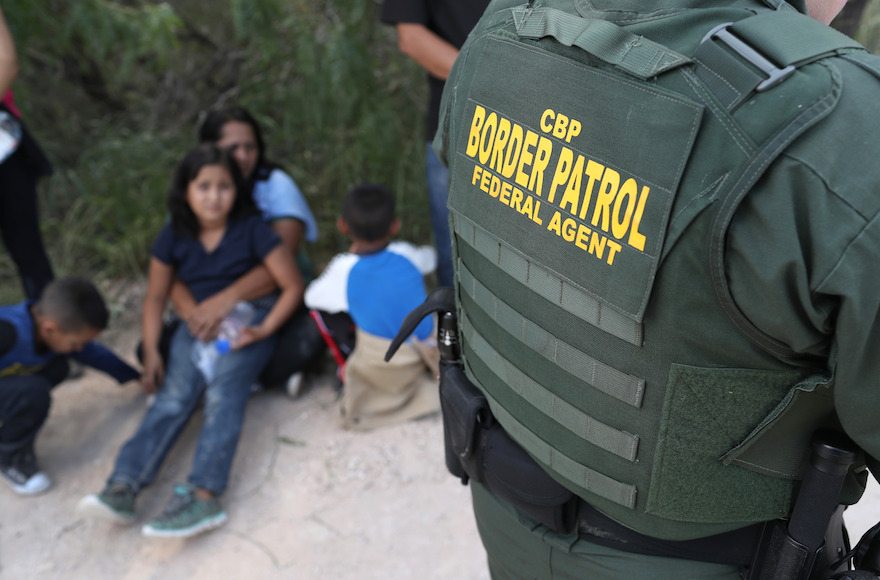
Central American asylum seekers wait as U.S. Border Patrol agents take them into custody near McAllen, Texas, June 12, 2018. (John Moore/Getty Images)
One legacy of Jewish immigration and the era of restrictions is that Jewish groups on the main became leading advocates for immigrants, both their own and other people. At the same time, even some liberals say this country can’t absorb all the world’s poor and others “yearning to be free” — or even if we could, it’s a perilous political issue. Can the Jewish support for immigration be sustained? Should it?
MH: It’s a good question. We have a responsibility to immigrants and refugees, and we have a responsibility to ourselves to meet the security and economic needs of this country. Part of that is border management. And part of border management and part of promoting a good economy and a strong country is to make sure that we have the labor that we need to fuel the economy and we don’t have that right now. There’s a massive labor shortage, and Congress has totally abdicated its responsibility on regulating immigration. They haven’t updated the immigration laws since 1986.
At the end of the day, why is history important to the immigration debate? What do we gain by looking at the past?
BW: I keep going back to this transformation of the nation in many ways. There’s one story we tell about American history, and then there’s this other story, and they don’t fit very comfortably together. We have to understand where nativism comes from, and there’s no question nativism motivated this legislation and all the things that are connected to it, including pseudoscience.
MH: We are living almost exactly what they were living in the 1920s when it comes to attitudes toward refugees, and immigrants, and the other, and it’s really dangerous and unsettling. And we saw what came after the 1920s in the rest of the world, with the rise in xenophobia, the rise of populism. All of these things that were happening in the 1920s are with us right now, all around us. And we saw where that took us in the ’30s and ’40s. Immigration is just one piece of that puzzle, but it’s a very telling one because the way that you treat refugees really is the canary in the coal mine. And that’s why we believe that the commandment to welcome the stranger is repeated 36 times in the Torah — because it’s so easily forgotten.
JTA has documented Jewish history in real-time for over a century. Keep our journalism strong by joining us in supporting independent, award-winning reporting.

